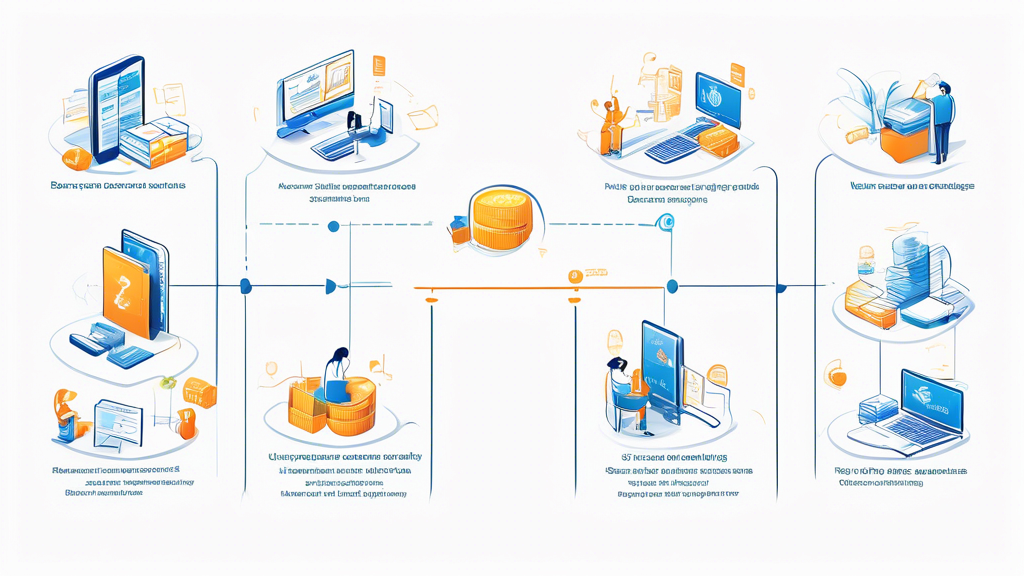A Guide to Kraken Margin Trading in the USA Understanding Margin Trading on Kraken Welcome…
Understanding the Basics of a Margin Trading Account

Welcome to the dynamic world of investing, where a margin trading account can open doors to enhanced financial flexibility and growth. A margin trading account serves as a powerful tool for traders, allowing them to borrow funds from their brokerage to purchase securities. This financial mechanism is pivotal in the investment world, as it enables traders to leverage their positions, potentially multiplying their gains and extending their purchasing power beyond their immediate capital. Margin trading accounts are typically utilized by more seasoned investors who understand the complexities and inherent risks involved. Whether you’re a savvy day trader looking to capitalize on short-term movements or a long-term investor aiming to maximize your market presence, mastering the basics of a margin trading account is crucial in navigating the investment landscape effectively.
Understanding margin trading accounts not only empowers investors with additional financial resources but also offers strategic advantages such as diversified investment opportunities and access to advanced trading options. However, while margin trading can amplify rewards, it’s essential to acknowledge the potential risks and challenges. Missteps in margin trading can lead to substantial losses, making it imperative for traders to grasp the concepts of margin calls and maintain adequate margin requirements. For newcomers eager to dive into margin trading, selecting the right broker is a vital step. It’s important to evaluate platforms based on their offerings, fees, and educational resources.
As you embark on your margin trading journey, fortify your knowledge with trusted educational materials and implement robust risk management strategies to safeguard your investments. Whether you’re just getting started or looking to refine your skills, understanding the framework and intricacies of a margin trading account is an invaluable asset in your financial toolkit. For more detailed information on margin trading, you can explore resources such as Investopedia’s guide on [margin trading](https://www.investopedia.com/terms/m/margintrading.asp) to help solidify your understanding.
Introduction to Margin Trading Accounts
What is a Margin Trading Account?
A margin trading account is a type of brokerage account that allows investors to borrow funds from a broker to purchase securities. This borrowing option is what distinguishes a margin account from a standard cash account. By using leverage, investors can increase their potential buying power, enabling them to acquire more assets than they could with their own capital alone. This account is particularly attractive for those looking to maximize their positions and take advantage of market movements effectively.
Importance and Purpose of Margin Trading Accounts in the Investment World
Margin trading accounts play a crucial role in the financial markets by providing investors with enhanced capabilities to implement more complex and aggressive trading strategies. Here are some reasons why margin accounts are significant:
- Enhanced Leverage: By leveraging borrowed funds, traders can potentially amplify their returns on investment. This is particularly appealing in bullish markets where securities prices are expected to rise.
- Increased Buying Power: With additional funds available, investors can diversify their portfolios more extensively or invest in higher-value stocks that may have otherwise been inaccessible.
- Short Selling: Margin accounts are essential for short selling, which involves selling securities not currently owned, betting on a decline in stock prices.
- Hedging Strategies: Investors can use margin accounts to hedge against potential losses in their portfolios, reducing the risk of adverse price movements.
Who Typically Uses Margin Trading Accounts?
Margin trading accounts are commonly used by a variety of investors, each with unique objectives and risk tolerance. These include:
- Experienced Traders: Veteran traders often utilize margin trading to capitalize on short-term market opportunities due to their deep understanding of market dynamics and risk management.
- Active Investors: Those who actively manage their portfolios may favor margin accounts to quickly adjust their positions based on market news and trends.
- Institutional Investors: Hedge funds and other institutional players use margin accounts to implement complex strategies that require significant leverage.
- Speculative Market Participants: Investors with a higher risk appetite interested in speculative moves often resort to margin trading to maximize potential gains.
It’s important to note that margin trading is best suited for those who thoroughly understand the intricacies of the market and have the financial capability to handle potential losses. Investors should always be aware that while the upside of margin trading is considerable, the risks, such as margin calls and increased liability, are equally significant.
For those new to the concept and looking for a deeper understanding, educational resources such as Investopedia’s Margin Account Explanation can offer valuable insights into the mechanics and risks involved in margin trading.
To further explore the benefits and risks of margin trading, continue to the next sections of this article.

Key Features and Benefits of Margin Trading Accounts
Margin trading accounts offer unique features and benefits that can greatly enhance an investor’s trading repertoire. Understanding these features is vital for investors looking to maximize their market engagements.
Main Features of a Margin Trading Account
- Access to Leverage: One of the primary features of a margin trading account is leverage, which allows investors to borrow funds to increase their purchasing power. This means that with a margin account, you can buy more securities than you could with just your funds.
- Increased Purchasing Power: By using leverage, investors can substantially enhance their purchasing power. This allows for more significant investment opportunities and the potential to profit from price movements that would otherwise be out of reach.
- Access to Diverse Markets: Margin accounts can provide access to a variety of markets, including stocks, bonds, forex, and commodities. This can help investors diversify their portfolios and explore new investment strategies.
How Margin Trading Can Potentially Amplify Gains
Margin trading can significantly amplify gains through the following mechanisms:
- Enhanced Returns: By utilizing borrowed funds, investors can purchase larger quantities of securities. If the value of these investments increases, the returns are amplified because the gains are based on the total investment, including the borrowed portion.
- Profit from Short Selling: Margin accounts allow for short selling, where investors sell securities they do not own, aiming to buy them back at lower prices. This can provide opportunities to profit from declining market trends.
It’s noteworthy that the same leverage that amplifies gains also increases the potential for losses, hence why a calculated approach is crucial.
Additional Benefits of Margin Trading Accounts
- Diversified Investment Strategies: With the flexibility to invest in a broader range of products and markets, investors can refine their strategies to align with their financial goals. This diversification can help mitigate risks and enhance returns.
- Access to Advanced Trading Options: Many margin trading accounts come with sophisticated tools and features, including real-time data streaming and advanced charting capabilities. These tools can aid in making informed investment decisions.
- Liquidity: Margin accounts can increase your buying power quickly, enabling you to take advantage of lucrative market opportunities that may arise abruptly.
These features and benefits make margin trading accounts a powerful tool for seasoned investors eager to take advantage of leveraging opportunities. However, it’s essential to approach margin trading with an in-depth understanding of the associated risks and a well-thought-out strategy.
For those interested in a deeper dive into the specifics of margin trading, the Investopedia Guide to Margin Accounts offers valuable insights and practical advice for potential investors.

### Risks and Challenges Associated with Margin Trading Accounts
Margin trading accounts offer the potential for significant gains, but they also come with inherent risks that investors need to be aware of. Understanding these risks and challenges is crucial to managing your investments effectively and ensuring that you don’t expose yourself to unnecessary financial strain.
#### Potential Risks Involved in Margin Trading
1. **Significant Losses**
– Leverage amplifies both gains and losses. A small decrease in the price of an asset can lead to a significant loss if the position is heavily leveraged.
– Example: If you’ve leveraged a position fivefold, a 10% drop in value results in a 50% loss on your investment.
2. **Margin Calls**
– Occurs when the value of your securities falls below a certain threshold, and your brokerage requires additional funds to cover potential losses.
– Investors need to deposit more funds or sell part of the holding to meet the margin requirements.
– Not meeting a margin call could result in your broker selling your assets without advance notice, which may not be at favorable prices.
3. **Volatility Risks**
– Markets can be highly volatile, and changes can occur rapidly. High volatility can lead to swift changes in your portfolio’s value.
– It’s crucial to have a plan in place to deal with large market swings that might happen because of geopolitical events, economic data releases, or other unexpected occurrences.
4. **Interest Costs**
– Borrowed funds incur interest costs that can accumulate over time, especially if positions are held for longer periods.
– These costs can reduce overall profitability, and understanding the interest rates charged by your broker is essential to managing this risk.
#### Common Challenges Traders May Face
1. **Understanding Complex Instruments**
– Margin trading often involves intricate financial products. Not fully understanding them can lead to strategic mistakes.
– It’s beneficial to educate yourself continuously on financial instruments to reduce the risk of missteps.
2. **Overleveraging**
– The temptation to take larger positions with borrowed money can lead to overleveraging, increasing the risk of substantial losses.
– Prudent leverage utilization is key to preserving capital and avoiding catastrophic losses.
3. **Psychological Pressures**
– Margin trading can be stressful, especially during downturns.
– It’s important to maintain discipline and avoid panic actions that could exacerbate losses.
4. **Liquidity Issues**
– In certain markets, liquidity can be an issue, leading to difficulties in executing trades at desired price points.
– This can be particularly challenging during market hours when rapid decisions are necessary.
#### Importance of Understanding Margin Calls and Maintaining Margin Requirements
1. **Margin Calls Explained**
– A broker-issued demand for additional capital to maintain a marginal position.
– Understanding when and why a margin call might occur is essential for proactive planning.
2. **Maintaining Margin Requirements**
– Ongoing awareness of your margin balance and required maintenance margin can prevent forced sales and financial penalties.
– Regular portfolio reviews and adjusting exposure can help in staying within limits.
3. **Broker’s Role**
– Brokers can liquidate positions if margin calls aren’t met, potentially compounding losses.
– Know your broker’s policies on margin trading to mitigate surprises.
To fully appreciate and mitigate the risks associated with margin trading, it’s advisable to regularly evaluate your risk tolerance and make use of available risk management tools such as stop-loss orders. Utilizing online resources and educational platforms can also be a great way to enhance your understanding and comfort with margin trading. Websites like [Investopedia](https://www.investopedia.com) and [the Financial Industry Regulatory Authority (FINRA)](https://www.finra.org) provide comprehensive guides and articles to deepen your grasp of margin trading and associated risks.

Getting Started with a Margin Trading Account
Step-by-step Guide on How to Open and Maintain a Margin Trading Account
Embarking on the journey of margin trading begins with setting up your margin trading account. This process involves a few essential steps to ensure that you start on the right foot. Here’s a comprehensive guide to help you.
- Research and Select a Broker: The first step in opening a margin trading account is to select a reputable broker. Consider factors like fee structures, available trading platforms, and margin requirements.
- Application Process: Once you’ve chosen a broker, fill out the application form. This typically requires personal details, financial background, and investment experience.
- Approval and Documentation: After submission, your application will undergo a review. Be prepared to provide additional documentation such as proof of income and a credit check.
- Deposit the Initial Margin: Upon approval, you’ll need to deposit the initial margin. This amount varies by broker but is generally a percentage of the total value of the margin account.
- Activating the Account: Once your funds are deposited, your margin trading account will become active, allowing you to start trading.
Tips for Choosing the Right Broker or Platform
Choosing the right broker for your margin trading account is crucial. Here are some tips to consider:
- Regulation and Security: Ensure the broker is regulated by a well-known financial authority.
- Cost Considerations: Look for brokers with competitive fees such as low interest on borrowed funds and reasonable commission rates.
- Platform Features: Choose a broker that offers a user-friendly platform with advanced tools like real-time market data, analysis tools, and mobile accessibility.
- Customer Support: Opt for brokers with excellent customer support available through various channels like chat, phone, and email.
- Educational Resources: Access to educational material can be invaluable, especially for beginner traders looking to understand the nuances of margin trading.
Recommendations for New Traders on How to Prepare for Margin Trading
Margin trading carries both potential rewards and substantial risks. Here are some key recommendations to get prepared:
- Educate Yourself: Leverage online courses, webinars, and books that cover the intricacies of margin trading. Websites like Investopedia offer in-depth guides.
- Practice with a Demo Account: Before plunging into real trading, utilize a demo account to familiarize yourself with trading strategies without financial risk.
- Set Clear Trading Goals: Define your trading objectives, risk tolerance, and time horizons to create a structured trading plan.
- Risk Management Strategy: Implement risk management techniques, such as setting stop-loss orders and avoiding over-leveraging, to protect against significant losses.
- Stay Informed: Regularly read financial news and analysis to stay informed about market trends that could impact your trades.
Successfully navigating the world of margin trading accounts begins with careful planning, choosing the right resources, and maintaining an informed perspective on market dynamics.
For more information on risk management strategies and market analysis, consider browsing resources such as TradingView and BabyPips which offer insights into trading strategies and market conditions.
In conclusion, understanding the basics of a margin trading account is crucial for any investor considering this form of trading. A margin trading account is an essential tool that allows investors to access leverage, increasing their purchasing power and enabling them to potentially amplify their gains. This type of account is especially important for investors looking to diversify their investment strategies and access more sophisticated trading options.
However, it is imperative to acknowledge the inherent risks and challenges associated with margin trading accounts. The use of leverage can result in significant losses, and traders must be aware of the critical aspects such as margin calls and the maintenance of margin requirements. This understanding underscores the importance of a well-informed approach, emphasizing that margin trading is typically suited for seasoned traders who are capable of managing these risks.
For those new to margin trading, there are several steps and considerations to ensure a solid start. Opening a margin trading account requires selecting the right broker or platform, understanding the account’s key features, and familiarity with the respective terms and conditions. Beginners are strongly encouraged to prepare themselves by utilizing educational resources and adopting risk management strategies. These may include setting clear stop-loss orders and maintaining a robust portfolio diversification strategy.
Ultimately, while margin trading accounts offer powerful advantages, such as enhanced investment capacity and greater market opportunities, they demand a comprehensive understanding and cautious approach. By recognizing both the potential benefits and the substantial risks associated, investors can make informed decisions that align with their financial goals and risk tolerance.
For further exploration, consider visiting resources such as Investopedia’s guide on margin trading (https://www.investopedia.com/terms/m/margintrading.asp) or the Financial Industry Regulatory Authority (FINRA) guidelines on margin accounts (https://www.finra.org/investors/learn-to-invest/types-investments/margin-accounts). These can provide more detailed insights and supplementary educational material to support effective margin trading practices.





